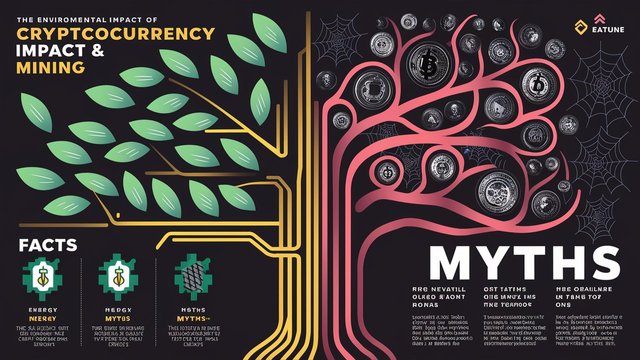The Environmental Impact of Cryptocurrency Mining: Myths and Facts

ideogram.ai picture
Cryptocurrencies have taken the world by storm, promising a revolution in how we conduct financial transactions. However, alongside the excitement comes a growing concern – the environmental impact of cryptocurrency mining. Separating myths from facts is crucial for a balanced understanding of this complex issue.
Myth 1: Crypto Mining is an Environmental Apocalypse
This is a common misconception. While cryptocurrency mining does consume a significant amount of energy, it's important to contextualize this impact. Traditional financial systems, with their reliance on physical infrastructure and vast networks of branches, also have a substantial environmental footprint. The key lies in understanding the nuances of energy consumption in cryptocurrency mining.
Fact 1: The Energy Consumption Debate
The energy consumption of cryptocurrency mining hinges on several factors. The type of cryptocurrency being mined is a major one. Bitcoin, for instance, utilizes a method called Proof-of-Work (PoW) to verify transactions. PoW requires significant computing power, which translates to high energy demands. However, alternative cryptocurrencies are emerging that employ more energy-efficient consensus mechanisms, like Proof-of-Stake (PoS).
Myth 2: All Crypto Mining is Dirty
Another misconception is that all mining operations are inherently bad for the environment. The truth is, the source of the energy powering the mining rigs significantly impacts the environmental equation. Many mining facilities are setting up shop in regions with abundant renewable resources like hydroelectricity in Scandinavia or geothermal energy in Iceland. By harnessing these clean sources, these miners can significantly reduce their carbon footprint.
Fact 2: The Rise of Renewables in Crypto Mining
The environmental impact of cryptocurrency mining is not static. A growing trend within the crypto community is the push towards sustainable mining practices. Several large-scale mining operations are actively transitioning towards renewable energy sources. This shift, if it continues, could significantly mitigate the environmental impact of cryptocurrency mining.
Myth 3: Every Crypto Transaction is Harmful
Critics often argue that every cryptocurrency transaction inherently contributes to the environmental problem. However, it's essential to recognize that not all cryptocurrencies operate on the same consensus mechanism. As mentioned earlier, PoW coins do require significant energy for transactions. However, PoS and other alternative consensus mechanisms are considerably more energy-efficient. For example, Ethereum, the world's second-largest cryptocurrency by market capitalization, is transitioning from PoW to PoS, which is expected to slash its energy consumption by a staggering amount.
Fact 3: Innovation is Key to Sustainable Crypto
Technological advancements are continuously shaping the cryptocurrency landscape. The development of more energy-efficient mining hardware and protocols is crucial for a sustainable future for crypto. Research and development efforts are underway to optimize mining processes and reduce their environmental footprint.
Beyond the Headlines: Human Impact and Local Communities
The environmental impact of cryptocurrency mining goes beyond global energy consumption. Large-scale mining operations can have a significant impact on local communities. Issues like noise pollution, heat generation, and the strain on local power grids are genuine concerns that need to be addressed. Sustainable mining practices must consider the well-being of local communities alongside the broader environmental impact.
The Human Touch: Finding Common Ground
The debate surrounding the environmental impact of cryptocurrency mining is often heated and polarized. However, it's important to remember that the vast majority of people involved in cryptocurrency, from miners to enthusiasts, share a common goal – a thriving and sustainable future. Finding common ground and fostering open communication between all stakeholders – miners, developers, regulators, and environmental groups – is essential for developing solutions that promote both technological innovation and environmental responsibility.
The future of cryptocurrency mining remains to be seen. However, by dispelling myths, embracing innovation, and prioritizing sustainability, the crypto community can ensure a future where digital currencies thrive without leaving a heavy footprint on the planet.
Thank you, friend!


I'm @steem.history, who is steem witness.
Thank you for witnessvoting for me.
please click it!
(Go to https://steemit.com/~witnesses and type fbslo at the bottom of the page)
The weight is reduced because of the lack of Voting Power. If you vote for me as a witness, you can get my little vote.
Upvoted! Thank you for supporting witness @jswit.